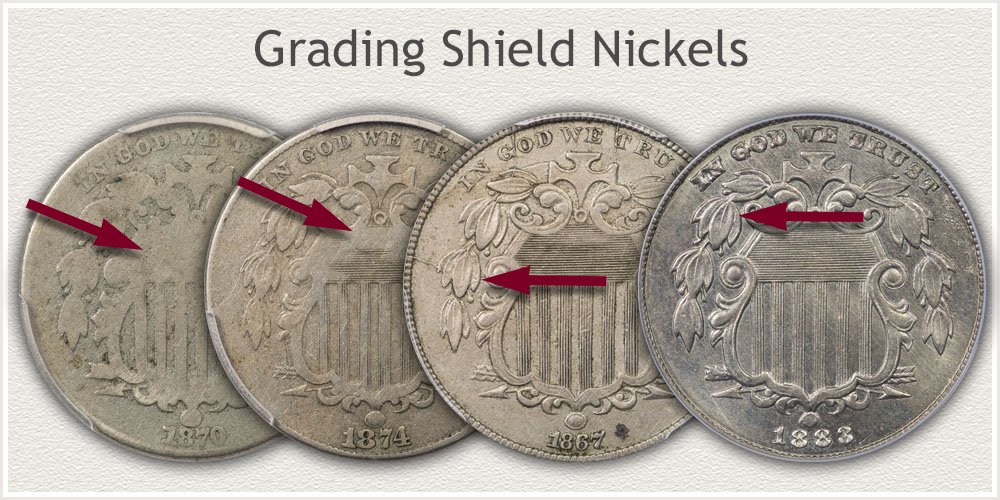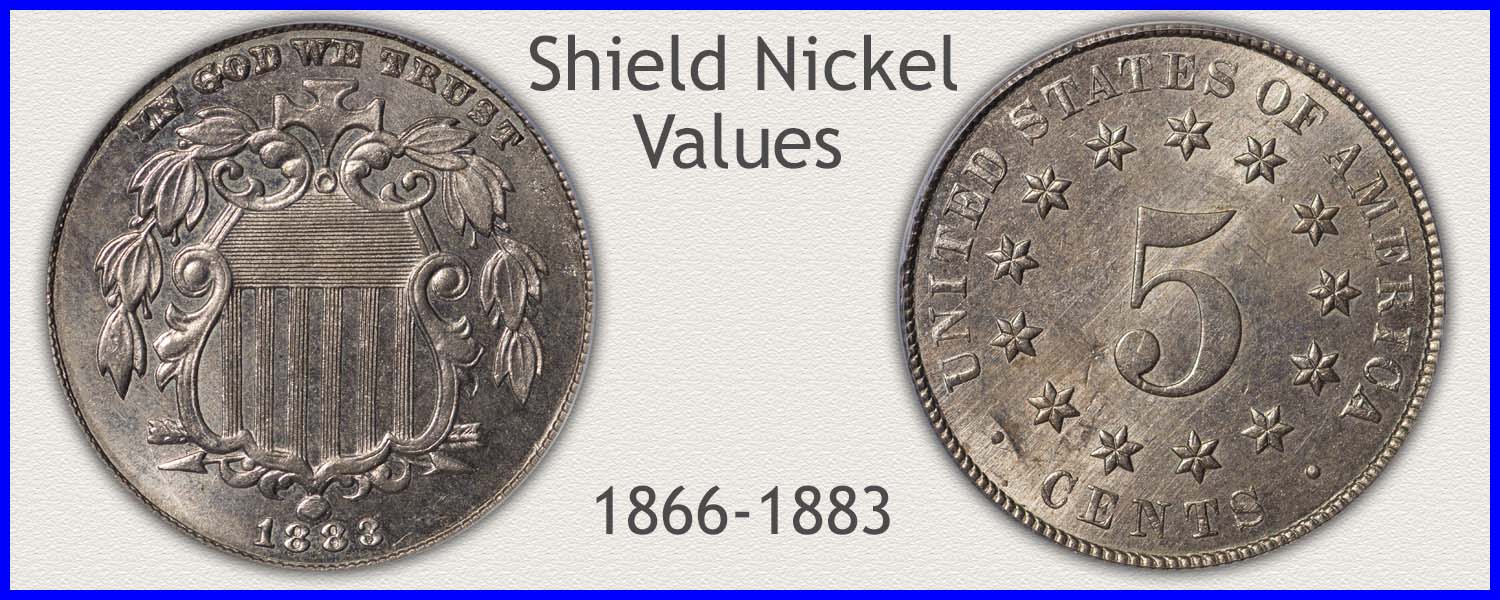Coin Values Moving with Precious Metals: Up-Dated 12/15/2025: Gold $4341 | Silver $63.26
Visual Grading Metrics
Shield Nickel Mint State Grade
At the Mint State condition level, a Shield Nickel displays no wear on any of the surface areas. Reference the Mint State nickel (fig. 1M); examine its overall look of excellent detail. All features remain as they were first struck. There is no visible disruption of the coin's luster or design elements in this grade. The coin projects a "glow" because of the reflective nature of luster.
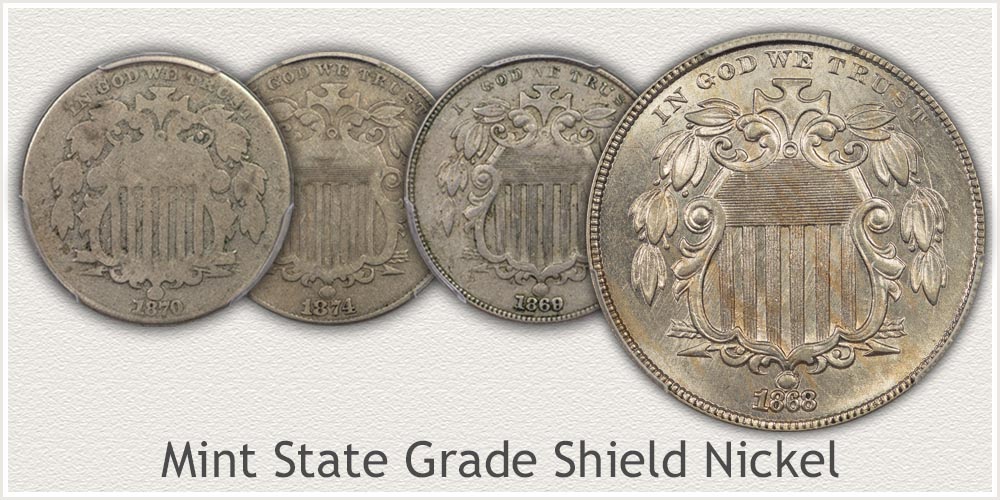 (fig. 1M) Verify a Close Match to the Mint State Condition Shield Nickel
(fig. 1M) Verify a Close Match to the Mint State Condition Shield Nickel
A close match of your coin's quality to the Mint State grade imaged requires further examination. Determining the "no wear" condition with accuracy qualifies a coin at this high condition.
Visual Grading Metrics Identify Shield Nickels in Mint State Grade
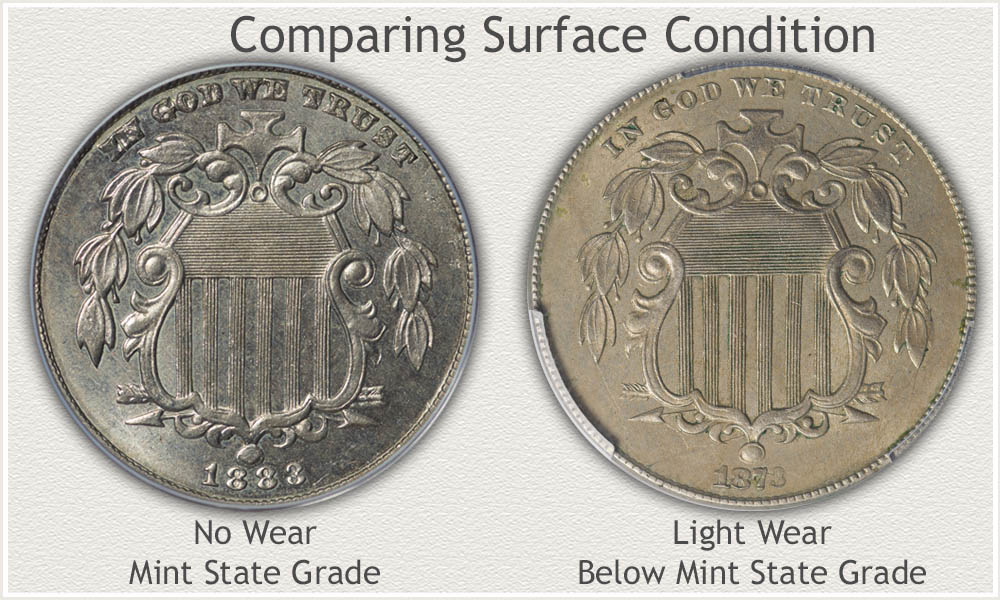 (fig. 2M) Different Surface Qualities of Mint State Compared to Lightly Worn Shield Nickel
(fig. 2M) Different Surface Qualities of Mint State Compared to Lightly Worn Shield Nickel
A defined method of grading begins the process of deciding on the condition of a Shield nickel. Preparing to grade a coin at the higher levels of preservation includes the following.
Qualities of a Mint State Surface
A primary visual feature of a Mint State coin is the presence of luster, its shine, over the entire surface of the metal. During the striking of a coin, metal moves over the striking die and into design features. The intense pressure and metal flow impart a distinct texture on the surface. Light reflecting off the original texture of a Mint State surface shines as luster.
The presence of this original texture becomes a visual metric. In Mint State Grade, original texture remains on both high points of the surface and in the low areas of the field.
Qualities of a Worn Surface
First signs of wear on a coin's surface appear as smoothness on the metal. Once the original surface wears, the appearance of the metal becomes different. Worn metal displays a different shade of color than unworn metal. Worn areas also display a metallic "shine." Additionally, raised contours flatten across their surface. All these changes happen in various degrees. They depend on the specific design feature showing wear. These various changed qualities become visual metrics.
Differences between a Mint State and a slightly worn surface are subtle. Visual indications have a certain degree of similarity. As example; different shades of color are possible due to toning on the metal and not wear. Additionally, a weak strike of the design, often causes missing areas of luster and texture. Applying many specific visual metrics to the entire coin and its features, develops an overall score; helping determine its grade level.
All Shield nickels appearing with similar qualities matching both coins in the above image (fig. 2M) become candidates for further examination.
Focal Points Used When Inspecting Surface Condition
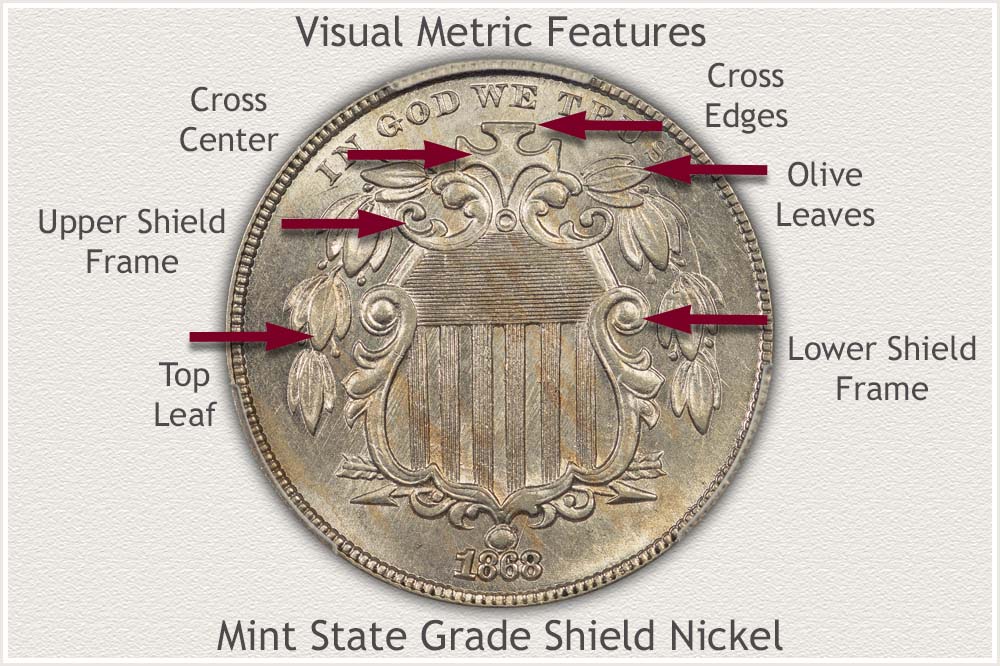 (fig. 3M) Features Used When Judging Mint State Shield Nickels
(fig. 3M) Features Used When Judging Mint State Shield Nickels
Highest points of the Shield Nickel's design (fig. 3M) become key areas used indicating no wear to its surface.
- Cross: Two Features Inspected
- Frame of the Shield: Four Areas Inspected
- Olive Branch Leaves: Eight Leaf Groups Inspected
Specific areas of the main elements closely inspected determine if the surface is in Mint State condition.
Research Data Provided by 39 Study Coins
For each of the visual metrics, a group of study coins was inspected and rated per metric. The group consisted of 39 professionally examined and graded Mint State Shield Nickels. The cumulative rating and scoring of these coins established baseline percentages of qualities needed for each visual metric. Matching these scores gives strong indications of condition and grade.
🔎Tools and Techniques Useful When Grading High Quality Shield Nickels Good lighting casting onto the coin and a magnified view of its surface are the primary aids when grading any coin. A single lamp with a 60 to 100 watt bulb provides the needed amount of light, highlighting the surface. Using a 5x to 7x power magnifying glass provides close-up viewing helping judge small details.
Holding the coin by its edges, rotate it under the light viewing the surface from different positions in reference to the light. Secondly, tilt the coin under the light to vary the angle light reflects off the surface. This combination of light and magnification identifies the visual qualities deciding condition.
Cross: Visual Grading Metrics: Condition of the Features
Above the shield, a cross feature provides high and low contour grading areas. High relief points run along the raised edging of the cross. Secondly, a raised center is part of the design detail within the cross. Comparing the low and high points indicates surface condition. Using a light source from the left side of the cross creates needed contrast on the metal surface. Inspect and judge both the raised edges and center area separately.
Visual Metric: Raised Edge of Cross
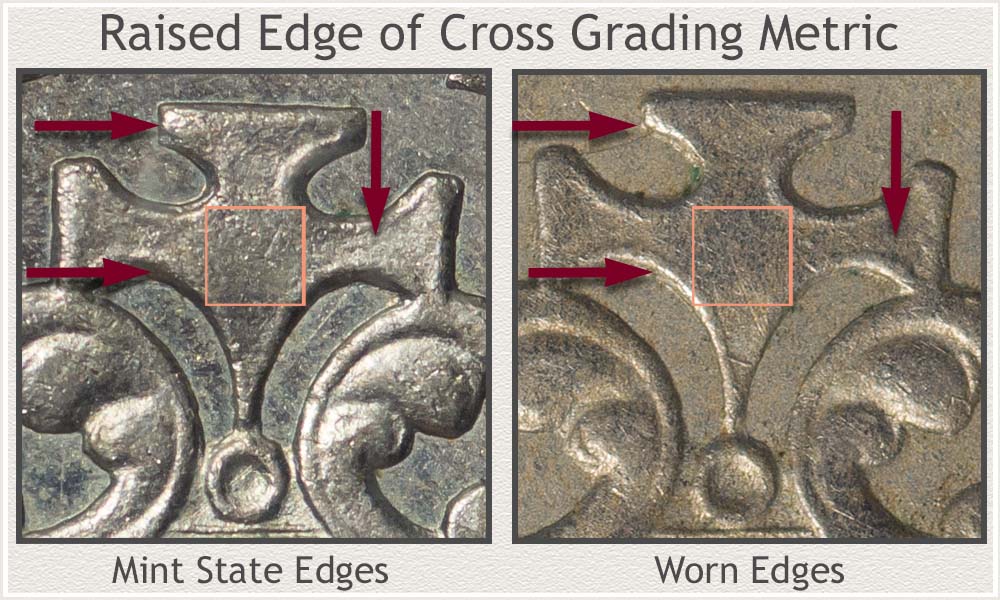 (fig. 4M) Visual Differences on a Mint State Cross Edge and a Worn Edge
(fig. 4M) Visual Differences on a Mint State Cross Edge and a Worn Edge
Various features of the cross supply detailed grading areas. Specifically, the outer raised edge running the perimeter. This edge, delicate in design, shows evidence of wear quickly. Dividing the cross into its arms defines the inspection method. Envision a square in the center of the cross identifying the inspection area of each arm.
Visual Rating Definitions | Raised Edge of Cross
Mint State: Notice the textured appearance of the metal illustrated (fig. 4M) along the raised edge. This is the appearance of the metal as minted. Compare the lower relief areas within the cross to determine a texture match.
Worn Metal: The high areas of the edge, when worn, appear as a distinct smoothness on their surface. This smooth metal often becomes a different color along with its smooth texture. Inspecting the edges of each arm separately helps see this difference in the metal surface. A flatness along this contoured edge also indicates wear.
Judge each arm as a separate grading area. Rate and record the number meeting the Mint State condition definition.
Rating: Raised Edge of Cross
|
4 Arms Mint State |
3 Arms Mint State |
2 Arms Mint State |
1 Arm Mint State |
This small and subtle edge detail provides useful grading insight of a Shield nickel's condition. Score the result of the ratings. 3 or 4 Mint State Arms of the Cross Rates a Positive Score.
Scoring: Raised Edges of Cross
|
|
Positive Score |
3 or 4 Mint State Arms
Research Data Results: Raised Edge of Cross
Study Group of 39 Mint State Grade Shield Nickels
The following are the percentage results of a close inspection of the Mint State nickels in the study group.
64% | Rated 4 Arms Mint State
36% | Rated 3 Arms Mint State
0% | Rated 2 or Less Arms Mint State
Conclusion/Key Points: The raised edge of the cross is a valuable insight into the condition of high quality Shield nickels. At this level of grading judgment, a strict evaluation becomes important. With 100% of the study nickels rating at least 3 Mint State arms, this becomes the deciding positive scoring. 36% rating 3 arms Mint State illustrates the need to included many evaluation points on a coin's surface. None of the study nickels rating 2 Mint State arms or fewer validates the high quality of the nickel. A Positive Score Metric: 3 to 4 Mint State Raised Edges
Visual Metric: Central High Contour of Cross
 (fig. 5M) Mint State and Worn Condition of the Center of the Cross
(fig. 5M) Mint State and Worn Condition of the Center of the Cross
At the center of the Cross is a small but important area. This center section rises in contour; forming a rounded profile. With its height comes a tendency to show any wear quickly. Inspecting the center provides an additional metric used to detect the difference between a Mint State or worn surface.
Visual Rating Definitions | Central Contour of Cross
Mint State Without wear, the center of the cross remains with a uniform, textured surface. Imaged (fig. 5M); notice the "grain" of the metal. This texture covers the top of the contour and matches the metal lower in relief. Examine the entire surface area within the raised edges, confirming a similar texture. A similar appearance in high and low areas indicates the Mint State condition. Of importance, a slight color change does not conclusively indicate wear on the metal.
Worn Surface Worn metal becomes smooth beginning at the high center of the raised contour. A slight color change often shows; however, this is not conclusive. A distinct smoothness of the metal surface helps confirm wear. Notice the difference in metal texture (fig. 5M) across the high center compared to lower contours within the arms. Smooth, worn metal on high points standout. Note: For this inspection, a change in color of the metal is not used as an indicator of wear.
Examine and Rate the center of the Cross, judging its condition as either Mint State or Worn.
Rating: Central Contour of Cross
|
Mint State |
Worn Condition |
Mint State Condition Rates a Positive Score and Meets the Mint State Grade. Scoring the condition of the Cross center adds another metric used when the examination of the coin is complete.
Scoring: Central Contour of Cross
|
|
Positive Score |
Mint State Condition
Research Data Results: Central Contour of Cross
Study Group of 39 Mint State Grade Shield Nickels
The study group of nickels contained a large amount of data. The percentage results of the close examine of the cross indicate the subtle judgment needed.
92% | Of the Nickels Rated Mints State at the Cross Center
8% | Of the Nickels Rated Worn Condition at the Cross Center
Conclusion/Key Points: A strong "Mint State" rating provides the metric for awarding a Positive Score. With 92% of the nickels achieving this rating; confidence of condition is high. Interestingly, 8% of the nickels indicated some wear within the cross. This interpretation of the surface is part of the judgment. Nickels with an overall high level of preservation need an accumulative evaluation of many areas.
Shield's Frame: Visual Grading Metrics
An ornate frame surrounds the horizontal and vertical line features of the shield. This frame has high and low relief areas useful to gauge signs of wear. One of the difficulties of grading the frame, it often suffers from a "Soft Strike." This is common to the Shield nickel series; many coins display incomplete strikes. A softly struck area appears flat across the top, confusing this flatness with wear. True wear appears as a smooth metal surface, an important difference from an incompletely struck area.
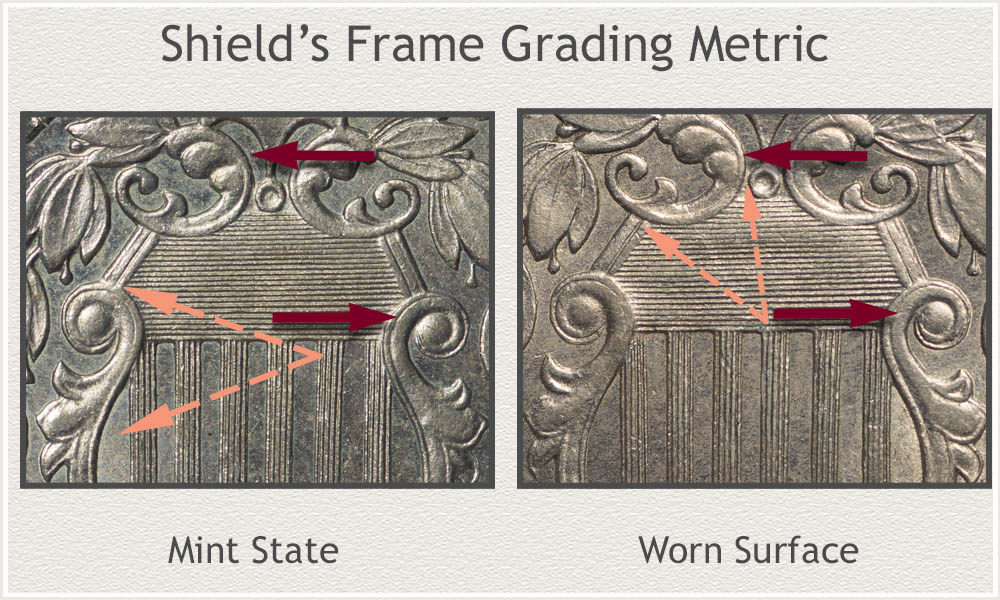 (fig. 6M) Comparing Mint State to Worn Shield Frame Elements
(fig. 6M) Comparing Mint State to Worn Shield Frame Elements
Dividing the frame into four areas and inspecting and rating each helps improve the quality of the evaluation. The top two curved areas above the horizontal lines are each judged and rated. Additionally, the two curved areas beside the horizontal lines are judged and rated separately. This gives a total of four inspection areas.
It is the texture of the metal along with its vibrance of shine evaluated to determine condition. Mint State and Worn metal have slightly different looks. Use these definitions when inspecting the quality of the metal surface of the frame and its parts.
Visual Rating Definitions | Shield's Frame
Mint State: Consistency of metal texture, showing a fine grain on the surface, indicates Mint State condition. Compare high points to lower relief areas. Inspect the high relief areas of the ball features and high areas of the curves. Compare the high contoured reliefs with lower areas and the area along the raised parts of the edges. Both high and low relief are consistent in luster and metal texture.
Worn Surface Illustrated (fig. 6M) shows the appearance of wear on the right side image. Notice the texture of the metal is smooth along high reliefs and clearly a different look. A distinct change in texture and shine covers worn metal. Gone are the crisp rounded features that run along the tops of raised "ball" elements. A dull sheen replaces the glow of luster along ridges. High relief areas are not as vibrant as lower recess areas.
Inspect the four frame areas, the two top curved elements, and two side curved elements. Rate each of the frame areas separately. Count those areas rating a Mint State condition. High count is 4 areas.
Rating: Shield's Frame
|
4 Areas Mint State |
3 Areas Mint State |
2 Areas Mint State |
1 Area Mint State |
Scoring the rating results accounts for the subtle surface conditions at this high grade level. 3 to 4 Mint State Areas Rates a Positive Score.
Scoring: Shield's Frame
|
|
Positive Score |
3 to 4 Mint State Areas
Research Data Results: Shield's Frame
Study Group of 39 Mint State Grade Shield Nickels
The following are the percentage rating results when inspecting the frame. These professionally graded Mint State nickels in the study group clearly demonstrate the subtle nature of Mint State condition.
80% | Rated All 4 Areas Mint State
20% | Rated 3 Areas Mint State
0% | Rated 2 or Few Areas Mint State
Conclusion/Key Points: An inspection of 39 Mint State nickels shows the frame device as an important area when detecting wear. Because the four areas are widely spread, confusion with soft strike areas is lessened. With 80% of the nickels showing all four areas without wear, this metric becomes important. Significantly, 100% rated 3 or more Mint State areas. Give a Positive Score to nickels with 3 or more Mint State areas.
Olive Branch Top Leaves: Visual Grading Metrics
Two olive branches on either side of the shield display many finely detailed leaves. Notice the design features 8 leaf groups, four on each side. This grading metric focuses on the top leaf of each group. These top leaves sit highest in profile, subject to the first signs of wear.
Each leaf design is both raised at the edges and center vein. The central area of the leaf is designed in lower relief, giving depth and dimension to the feature.
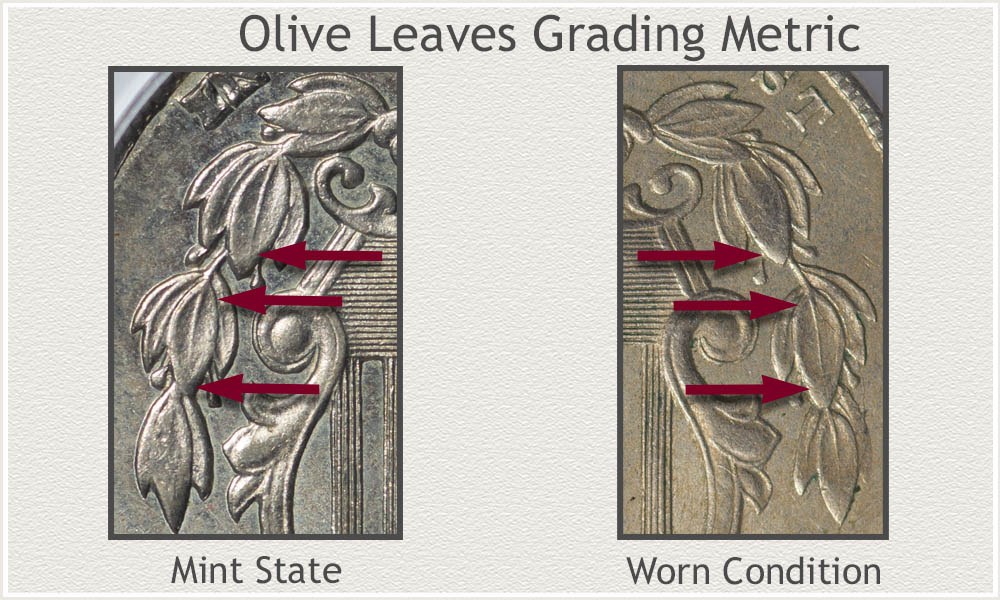 (fig. 7M) Compare the Quality of Mint State and Worn Condition Top Leaves
(fig. 7M) Compare the Quality of Mint State and Worn Condition Top Leaves
To properly judge condition of the 8 Top Leaves, three areas become focal points.
- Base of Leaf Where Raised Edges and Raised Inner Vein Meet
- Edges of Leaf Leading Towards Tip
- Tip of Leaf
Using these focal points plus grading descriptions, define the differences needed to separate Mint State condition from a worn surface.
Visual Rating Definitions | Olive Branch Top Leaves
Mint State: In Mint State condition leaves remain without signs of smoothing or flattening on the delicate raised areas. The base of the leaf, raised edges, and the tip remain with a fine grain texture. Focus on these three areas. Start with the edges and vein where they meet. Next, the edges traveling towards the tip. Finish by inspecting the leaf tip for a difference in texture. Compare the lower areas of metal with high points for consistency.
Worn Surface: Because of the small surfaces, leaf edges, veins, and tips wear quickly. Inspect the top leaf of the groups, comparing the high areas with low areas. Smooth metal along edges indicates wear. Any flatness of the metal becomes a strong indication of wear. Refer to the illustration (fig. 7M); focus on areas of the Mint State leaves with areas on the Worn Surface leaves. The surface of worn metal changes to a dull sheen verses the glow of unworn metal.
Rate the condition of each top leaf. Count and record the number displaying a Mint State condition.
Rating: Olive Branch Top Leaves
|
7 to 8 Top Leaves Mint State |
4 to 6 Top Leaves Mint State |
3 or Fewer Top Leaves Mint State |
Judging condition of Shield nickels at this high quality, strictly adheres to the grade definitions of the leaf surfaces. 7 to 8 Top Leaves as Mint State Rates a Positive Score. This score, in combination with the other rating scores, indicate an overall grading metric.
Scoring: Olive Branch Top Leaves
|
|
Positive Score |
7 to 8 Top Leaves Mint State
Research Data Results: Olive Branch Top Leaves
Study Group of 39 Mint State Grade Shield Nickels
The following are the percentage results of this visual metric applied to the study group of 39 Mint State nickels.
79% | All 8 Top Leaves Mint State
21% | 7 Top Leaves Mint State
0% | 6 or Fewer Top Leaves Mint State
Conclusion/Key Points: Inspecting all the small details of the leaves proves they are strong indicators of condition. A significant number, 79% of the 39 Mint State grade nickels displayed no wear on all leaf groups. The 21% group with 7 top leaves as Mint State is the result of being conservative and not counting an unsure condition. Because none of the study coins rated 6 or fewer top leaves Mint State, this becomes a strong quality indication. Once wear begins to show on the surface, it affects multiple areas. Use 7 to 8 Top Leaves rating Mint State as a Positive Score
Final Visual Metric Scoring | Mint State Grade Shield Nickel
Beginning with an initial assessment of deciding if a coin retains all original mint luster. A total of 17 distinct areas of the Shield nickel were inspected, rated, and scored using strict grading metrics. These individual scores are now combined into a Final Score indicating if the coin rates at the Mint State level of preservation.
Enter the scoring result from above into a Final Score.
A Final Score of 4 Positive Metrics indicates a Shield Nickel within the Mint State grade level.
Final Scoring: Visual Metrics Mint State Grade Shield Nickel
4 Positive Metrics
Rates a Positive Final Score
|
Positive Score |
Design Device |
Visual Grade Metric |
|
|
Raised Edges of Cross |
3 to 4 Mint State Arms |
|
|
Center Contour of Cross |
Mint State |
|
|
Shield's Frame |
3 to 4 Mint State Arms |
|
|
Olive Branch Leaves |
7 to 8 Top Leaves Mint State |
Research Data Results: Final Scoring Mint State Grade Shield Nickel
Study Group of 39 Mint State Grade Shield Nickels
Percentage Breakdown of Final Score Data
92% | Four Metrics Positive
8% | Three Metrics Positive
Conclusion/Key Points: All 39 nickels within the study group scored high. This is a group of coins displaying well above average condition. The standout percentage is the 92% scoring all metrics positive. This becomes the deciding factor. A small 8% achieved 3 positive metrics. This indicates judging subtle qualities at this level of condition becomes subjective. 4 positive metrics lend confidence to the Mint State grade.
Mint State enjoys a high level of importance within the coin hobby. This top-quality condition increases both collector interest and Shield Nickel Value
References
U.S. Mint. Symbols on Our Coins
https://www.usmint.gov/learn/history/us-circulating-coins
Department of State The Great Seal of the United States July 2003
U.S. Mint. Catalogue of Coins of the United States
https://nnp.wustl.edu/library/book/554591
Coin Values | CoinStudy Articles
Shield Nickel | Visual Grading Metrics Series
Visual Grading Metrics: Shield Nickels Extremely Fine Grade
Visual Grading Metrics: Shield Nickels Fine Grade
Visual Grading Metrics: Shield Nickels Good Grade
How to Grade Shield Nickels | Visual Guide
Shield Nickel: Judging the condition of these old nickels at high levels of preservation becomes technical. Start the process with an overview of the grades, magnified images, plus video. Review various conditions and begin an in depth understanding of how to grade these Shield nickels.
Shield Nickel Value | Condition and Grade Determine Worth
Once a Shield Nickel fits into the above average condition category, scarcity of the coin increases. The market rewards top level condition with high values. Reference the value chart listing all dates and the different levels of condition.
★Coin Values Discovery... finds Old Nickel Values and...
All old US coin values. Review the index of coin images, helping identify each series, from Cents to Gold. Value charts, grading images, plus descriptions uncover how much your box of old coins is worth. Begin the step-by-step value process for each coin series.
